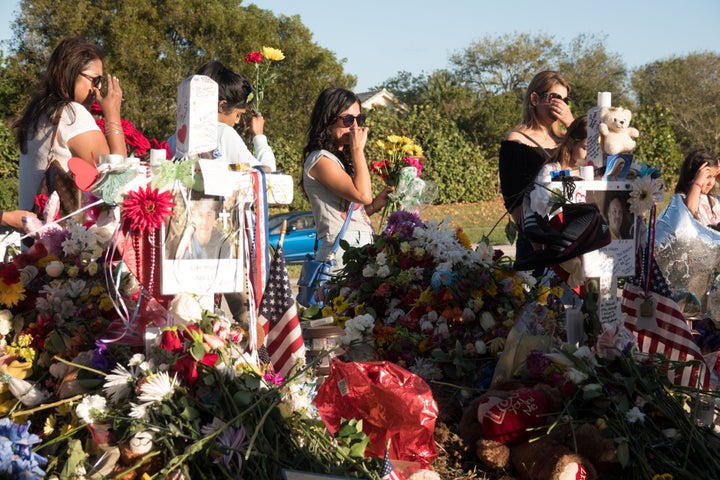
School shootings have shaped the experiences of a generation of younger Americans, a new survey shows. But there’s not a lot of evidence that living through so many massacres has changed young people’s views about gun control.
Young Americans worried about school shootings — and practiced how to survive them — more often than their parents and grandparents did, a new HuffPost/YouGov poll finds. Around a fifth of Americans under age 45 say that, growing up, they were at least somewhat worried about a mass shooting at their school. Just 7 percent of people 45 and older remember being similarly worried. Not a single person polled who was over the age of 65 said that, as a child, they practiced what to do in the event of a school shooting. Just 2 percent of those aged 45-64, and 12 percent of those aged 30-44, had practiced how to survive a shooting. But for adults under age 30, the figure rose to nearly one-third.
On average, people over age 65 said that the first mass shooting they could remember didn’t take place until they were 50 years old. People under age 30 said, on average, that they were 12.
Overall, more than 80 percent of Americans say they feel mass shootings have grown more common in the past decade. (Whether such shootings have actually become more common, or simply more deadly, appears to depend on exactly how they’re measured.)
What’s less clear is what effect this all might have on young Americans’ views about gun control. Several recent polls have found a sharp uptick in support for new gun control laws. But in many surveys, younger adults don’t appear especially likely to stand behind such efforts.
Adults under age 30 are more likely than older Americans to believe that Congress should take action to reduce shootings, according to another HuffPost/YouGov survey taken just after the massacre in Parkland, Florida, but they’re less likely to favor making gun laws stricter, or to count gun issues among their top priorities. A Marist poll found similar results, with 64 percent of 18-to-29-year-old voters favoring more stringent gun laws, compared to 71 percent among voters as a whole. Adults under 45 have virtually the same opinion of the National Rifle Association as do those age 45 and older, according to results from CNN and the polling firm SSRS.
None of those polls capture the views of those currently under the age of 18, who are only rarely surveyed.
The Florida high school shooting spurred many surviving students into gun control activism, and sparked school walkouts nationwide. Their movement has already seen tangible effects, with companies ditching their affiliation with the NRA and Florida’s Republican governor announcing a proposal to increase restrictions on gun buying.
“Now that you’ve had an entire generation of kids growing up around mass shootings, and the fact that they’re starting to be able to vote, explains how we’re going to have this change,” Parkland survivor David Hogg told ABC in an interview. “Kids are not going to accept this.”
It’s less clear to what extent their opinions, and enthusiasm for the issue, carries on to their peers. But there’s evidence to suggest that those currently in school are being more acutely exposed to the threat of school shootings than the generations before them.
In the decade between 2003 and 2013, the share of public schools conducting active shooter drills rose from about 47 percent to just above 70 percent, according to statistics reported by Vox.
A third of parents with children under 18 in the HuffPost/YouGov poll say they’ve talked to their children about the Florida shooting. Asked about those conversations, many said they’d encouraged their children to tell an adult if they saw another student acting strangely or making threats.
Parents also tried to offer advice on how to react in the event of a shooting. “Hide. Escape at the first possible safe moment. Do not try to stop the person. Be very quiet,” one woman said she’d suggested. Another woman said she’d told her child to “grab books and put [them in a] book bag and place in front of chest to act as a bulletproof vest.”
Some said they’d discussed opinions on policies, which ranged from a belief that armed teachers could have “truly protected their students” to a conviction that when it comes to a gun like an AR-15, “no “normal person needs that kind of weaponry.”
And others said they’d simply had to reassure their children.
“My 5-year-old wanted to know if he was going to have to fight a shooter at school,” one mother said.
Use the widget below to further explore the results of the HuffPost/YouGov survey, using the menu at the top to select survey questions and the buttons at the bottom to filter the data by subgroups:
The HuffPost/YouGov poll consisted of 1,000 completed interviews conducted Feb. 20-22 among U.S. adults, using a sample selected from YouGov’s opt-in online panel to match the demographics and other characteristics of the adult U.S. population.
HuffPost has teamed up with YouGov to conduct daily opinion polls. You can learn more about this project and take part in YouGov’s nationally representative opinion polling. More details on the polls’ methodology are available here.
Most surveys report a margin of error that represents some, but not all, potential survey errors. YouGov’s reports include a model-based margin of error, which rests on a specific set of statistical assumptions about the selected sample rather than the standard methodology for random probability sampling. If these assumptions are wrong, the model-based margin of error may also be inaccurate. Click here for a more detailed explanation of the model-based margin of error.

